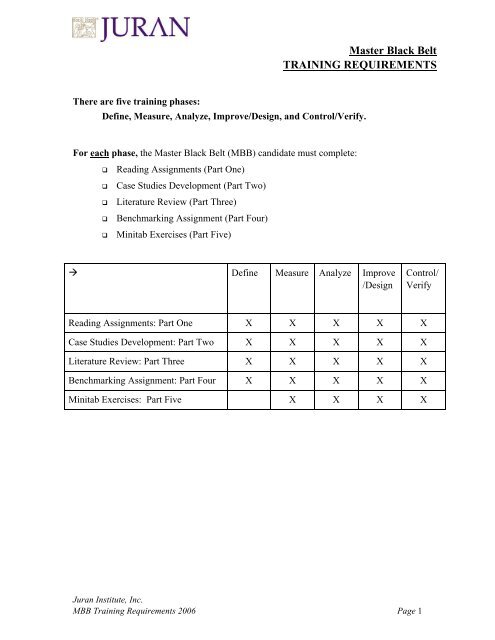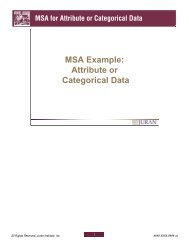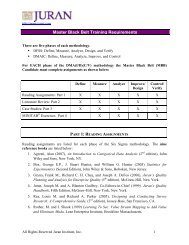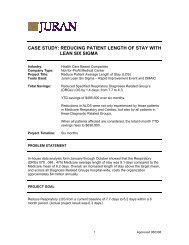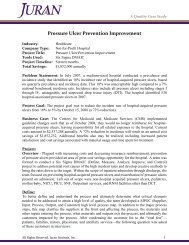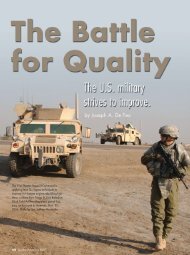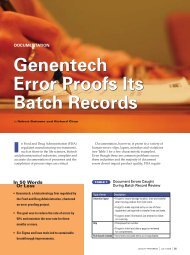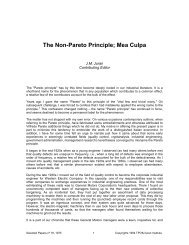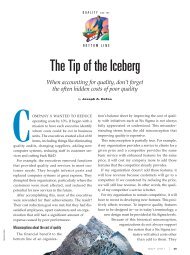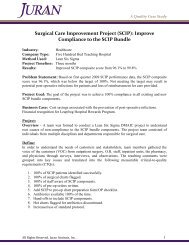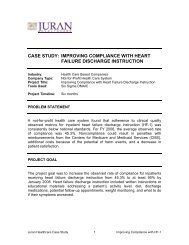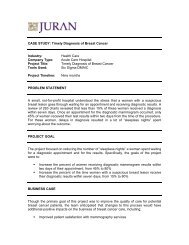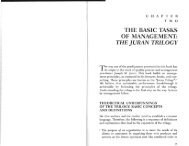Six Sigma Master Black Belt Requirements.pdf - Juran Institute
Six Sigma Master Black Belt Requirements.pdf - Juran Institute
Six Sigma Master Black Belt Requirements.pdf - Juran Institute
You also want an ePaper? Increase the reach of your titles
YUMPU automatically turns print PDFs into web optimized ePapers that Google loves.
<strong>Master</strong> <strong>Black</strong> <strong>Belt</strong><br />
TRAINING REQUIREMENTS<br />
There are five training phases:<br />
Define, Measure, Analyze, Improve/Design, and Control/Verify.<br />
For each phase, the <strong>Master</strong> <strong>Black</strong> <strong>Belt</strong> (MBB) candidate must complete:<br />
<br />
<br />
<br />
<br />
<br />
Reading Assignments (Part One)<br />
Case Studies Development (Part Two)<br />
Literature Review (Part Three)<br />
Benchmarking Assignment (Part Four)<br />
Minitab Exercises (Part Five)<br />
Define Measure Analyze Improve<br />
/Design<br />
Control/<br />
Verify<br />
Reading Assignments: Part One X X X X X<br />
Case Studies Development: Part Two X X X X X<br />
Literature Review: Part Three X X X X X<br />
Benchmarking Assignment: Part Four X X X X X<br />
Minitab Exercises: Part Five X X X X<br />
<strong>Juran</strong> <strong>Institute</strong>, Inc.<br />
MBB Training <strong>Requirements</strong> 2006 Page 1
<strong>Master</strong> <strong>Black</strong> <strong>Belt</strong><br />
TRAINING REQUIREMENTS<br />
PART ONE: READING ASSIGNMENTS<br />
Reading assignments are listed for each phase of the <strong>Six</strong> <strong>Sigma</strong> methodology. The six<br />
reference books are listed below:<br />
• Agresti, Alan (1996), An Introduction to Categorical Data Analysis, John Wiley and<br />
Sons, New York, NY.<br />
• DeVor, Richard E; Tsong-how Chang, and John W. Sutherland (1992), Statistical Quality<br />
Design and Control, Prentice Hall, Upper Saddle River, New Jersey.<br />
• Gryna, Frank M., Richard C. H. Chua, and Joseph A. DeFeo (2006), <strong>Juran</strong>’s Quality<br />
Planning and Analysis for Enterprise Quality (5 th edition), McGraw-Hill, New York.<br />
• <strong>Juran</strong>, Joseph M. and A. Blanton Godfrey, Co-Editors-in-Chief (1999), <strong>Juran</strong>’s Quality<br />
Handbook, Fifth Edition, McGraw-Hill, New York, New York.<br />
• Rea, Louis M. and Richard A. Parker (1997), Designing and Conducting Survey<br />
Research: A Comprehensive Guide, (2 nd edition), Jossey-Bass, San Francisco, CA.<br />
• Sprent, P. and N.C. Smeeton (2001), Applied Nonparametric Statistical Methods,<br />
Chapman & Hall/CRC, Boca Raton, Florida.<br />
PART ONE DELIVERABLES:<br />
• For each reading assignment the MBB candidate must list one to three key points on<br />
why the reading assignment is applicable. For example, Latin Square Design - how<br />
and when this concept or tool can be applied in your company to strengthen the <strong>Six</strong><br />
<strong>Sigma</strong> program? And if not applicable, indicate why.<br />
<strong>Juran</strong> <strong>Institute</strong>, Inc.<br />
MBB Training <strong>Requirements</strong> 2006 Page 2
<strong>Master</strong> <strong>Black</strong> <strong>Belt</strong><br />
TRAINING REQUIREMENTS<br />
DEFINE PHASE – READING ASSIGNMENTS (DEF01 through DEF07)<br />
<strong>Juran</strong>, Joseph M. and A. Blanton Godfrey, Co-Editors-in-Chief (1999), <strong>Juran</strong>’s Quality<br />
Handbook, Fifth Edition, McGraw-Hill, New York, New York.<br />
• DEF01 How to Think about Quality: Section 2<br />
• DEF02 Quality and Income: Section 7<br />
• DEF03 Quality and Costs: Section 8<br />
• DEF04 Strategic Deployment: Section 13<br />
Gryna, Frank M., Richard C. H. Chua, and Joseph A. DeFeo (2006), <strong>Juran</strong>’s Quality<br />
Planning and Analysis for Enterprise Quality (5 th edition), McGraw-Hill, New York.<br />
• DEF05 Companywide Assessment of Quality: Chapter 2<br />
• DEF06 Quality Improvement and Cost Reduction: Chapter 3<br />
• DEF07 Operational Quality Planning and Sales Income: Chapter 4<br />
MEASURE PHASE – READING ASSIGNMENTS (MEA01 through MEA08)<br />
DeVor, Richard E; Tsong-how Chang, and John W. Sutherland (1992), Statistical Quality<br />
Design and Control, Prentice Hall, Upper Saddle River, New Jersey.<br />
• MEA01 Importance of Rational Sampling: Chapter 7<br />
• MEA02 Process Capability Assessment: Chapter 9<br />
<strong>Juran</strong>, Joseph M. and A. Blanton Godfrey, Co-Editors-in-Chief (1999), <strong>Juran</strong>’s Quality<br />
Handbook, Fifth Edition, McGraw-Hill, New York, New York.<br />
• MEA03 Measurement, Information, and Decision-Making: Section 9<br />
• MEA04 Inspection and Tests: Section 23<br />
• MEA05 Basic Statistical Methods: Section 44<br />
Gryna, Frank M., Richard C. H. Chua, and Joseph A. DeFeo (2006), <strong>Juran</strong>’s Quality<br />
Planning and Analysis for Enterprise Quality (5 th edition), McGraw-Hill, New York.<br />
• MEA06 Understanding Customer Needs: Chapter 10<br />
Rea, Louis M. and Richard A. Parker (1997), Designing and Conducting Survey Research: A<br />
Comprehensive Guide, (2 nd edition), Jossey-Bass, San Francisco, CA.<br />
• MEA07 Part One: Developing and Administering Questionnaires<br />
• MEA08 Part Two: Ensuring Scientific Accuracy<br />
<strong>Juran</strong> <strong>Institute</strong>, Inc.<br />
MBB Training <strong>Requirements</strong> 2006 Page 3
<strong>Master</strong> <strong>Black</strong> <strong>Belt</strong><br />
TRAINING REQUIREMENTS<br />
ANALYZE PHASE – READING ASSIGNMENTS (ANA01 through ANA14)<br />
Agresti, Alan (1996), An Introduction to Categorical Data Analysis, John Wiley and Sons,<br />
New York, NY.<br />
• ANA01 Introduction: Chapter 1<br />
• ANA02 Two-Way Contingency Tables: Chapter 2<br />
• ANA03 Three-Way Contingency Tables: Chapter 3<br />
• ANA04 Generalized Linear Models: Chapter 4<br />
• ANA05 Logistic Regression: Chapter 5<br />
P. Sprent and N.C. Smeeton (2001), Applied Nonparametric Statistical Methods Hollander,<br />
Chapman & Hall/CRC, Boca Raton, Florida.<br />
• ANA06 Introducing nonparametric methods: Chapter 1<br />
• ANA07 Centrality inference for single samples: Chapter 2<br />
• ANA08 Methods for paired samples: Chapter 4<br />
• ANA09 Method for two independent samples: Chapter 5<br />
• ANA10 Three or more samples: Chapter 6.1 to 6.3<br />
• ANA11 Correlation and Concordance: Chapter 7<br />
• ANA12 Robust estimation: Chapter 11.1 to 11.3<br />
Gryna, Frank M., Richard C. H. Chua, and Joseph A. DeFeo (2006), <strong>Juran</strong>’s Quality<br />
Planning and Analysis for Enterprise Quality (5 th edition), McGraw-Hill, New York.<br />
• ANA13 Designing for Quality: Chapter 11<br />
Rea, Louis M. and Richard A. Parker (1997), Designing and Conducting Survey Research: A<br />
Comprehensive Guide, (2 nd edition), Jossey-Bass, San Francisco, CA.<br />
• ANA14 Part Three: Presenting and Analyzing Survey Results<br />
IMPROVE/DESIGN PHASE – READING ASSIGNMENTS (IMP01 through IMP05)<br />
<strong>Juran</strong>, Joseph M. and A. Blanton Godfrey, Co-Editors-in-Chief (1999), <strong>Juran</strong>’s Quality<br />
Handbook, Fifth Edition, McGraw-Hill, New York, New York.<br />
• IMP01 Design and Analysis of Experiments: Section 47<br />
DeVor, Richard E; Tsong-how Chang, and John W. Sutherland (1992), Statistical Quality<br />
Design and Control, Prentice Hall, Upper Saddle River, New Jersey.<br />
• IMP02 Model Building for Design and Improvement Using Two-Level<br />
Factorial Designs: Chapter 18<br />
• IMP03 Two-Level Fractional Factorial Designs: Chapter 19<br />
• IMP04 Robust Design Case Studies: Chapter 21<br />
<strong>Juran</strong> <strong>Institute</strong>, Inc.<br />
MBB Training <strong>Requirements</strong> 2006 Page 4
<strong>Master</strong> <strong>Black</strong> <strong>Belt</strong><br />
TRAINING REQUIREMENTS<br />
Gryna, Frank M., Richard C. H. Chua, and Joseph A. DeFeo (2006), <strong>Juran</strong>’s Quality<br />
Planning and Analysis for Enterprise Quality (5 th edition), McGraw-Hill, New York.<br />
• IMP05 Statistical Tools for Designing for Quality: Chapter 19<br />
CONTROL/VERIFY PHASE – READING ASSIGNMENTS (CON01 through CON7)<br />
<strong>Juran</strong>, Joseph M. and A. Blanton Godfrey, Co-Editors-in-Chief (1999), <strong>Juran</strong>’s Quality<br />
Handbook, Fifth Edition, McGraw-Hill, New York, New York.<br />
• CON01 The Quality Control Process: Section 4<br />
• CON02 Quality in Research and Development: Section 19<br />
• CON02 Operations: Section 22<br />
• CON04 Statistical Process Control: Section 45<br />
• CON05 Reliability Concepts and Data Analysis: Section 48<br />
DeVor, Richard E; Tsong-how Chang, and John W. Sutherland (1992), Statistical Quality<br />
Design and Control, Prentice Hall, Upper Saddle River, New Jersey.<br />
• CON06 Conceptual Framework for Statistical Process Control: Chapter 4<br />
• CON07 Cumulative-Sum Control Charts: Chapter 12<br />
<strong>Juran</strong> <strong>Institute</strong>, Inc.<br />
MBB Training <strong>Requirements</strong> 2006 Page 5
<strong>Master</strong> <strong>Black</strong> <strong>Belt</strong><br />
TRAINING REQUIREMENTS<br />
PART TWO: CASE STUDIES DEVELOPMENT<br />
PART TWO DELIVERABLES:<br />
Two case studies of real projects (or edited projects) are to be developed:<br />
• DMAIC transactional (i.e., business process) project case study, and<br />
• DMADV design project case study.<br />
The goal is to use these case studies as flow-through project case studies when teaching a<br />
<strong>Black</strong> <strong>Belt</strong> (or Green <strong>Belt</strong> with statistics) wave of Transactional DMAIC and Design for <strong>Six</strong><br />
<strong>Sigma</strong> DMADV, respectively.<br />
The MBB Candidate is expected to use real (or edited) projects to develop the case study<br />
narrative, data, graphs, Minitab printouts, and questions for breakout exercises in which the<br />
class participants can analyze (using Minitab as appropriate) and discuss as they move<br />
through each phase of the <strong>Six</strong> <strong>Sigma</strong> training. For example, how would one conduct an MSA<br />
for this project given the context of this project? In a follow-up exercise, after data has been<br />
“collected” and provided to the participants, they can analyze the data using Minitab to arrive<br />
at their own conclusions on whether the measurement system is valid. They can then discuss<br />
and propose the correct next steps.<br />
Handouts on the breakout exercises (scenario and questions), follow-up data, questions, and<br />
answer keys must be developed. Essentially, the handouts (and supplementary documents)<br />
build the case study as additional narrative, data, graphs, questions, and exercises become<br />
available through each step and each phase of the <strong>Six</strong> <strong>Sigma</strong> methodology. In summary, it is<br />
a build-up of information (i.e. multiple handouts) as more is known about the case study,<br />
similar to what typically happens in a real <strong>Six</strong> <strong>Sigma</strong> project. There should be at least one<br />
breakout exercise in Define, and at least two breakout exercises in each of the remaining<br />
phases (MAIC and MADV respectively).<br />
These teaching case studies will be reviewed and critiqued by a <strong>Juran</strong> specialist as they are<br />
being developed. Constructive feedback will be given to ensure the quality of the teaching<br />
case study. In summary, the deliverables are:<br />
• Two project case studies in Word, PowerPoint and/or Excel and Minitab, with data files,<br />
graphs, charts and output, narratives, questions, breakout exercises, and answer keys with<br />
data-driven conclusions.<br />
• Instructor summary notes to accompany the project case studies.<br />
• Summary of your critique of strengths and weaknesses of approach taken, narrative,<br />
methods and exercises used and conclusions, in preparation for review with <strong>Juran</strong>.<br />
<strong>Juran</strong> <strong>Institute</strong>, Inc.<br />
MBB Training <strong>Requirements</strong> 2006 Page 6
<strong>Master</strong> <strong>Black</strong> <strong>Belt</strong><br />
TRAINING REQUIREMENTS<br />
PART THREE: LITERATURE REVIEW<br />
For each phase, conduct a Literature Review to identify two new references shedding<br />
additional insight on concepts, tools, methods or applications for each phase. This literature<br />
search should be outside of the basic texts and articles used in <strong>Juran</strong>’s DMAIC and DMADV<br />
workshops and, preferably, of recent contributions to the field.<br />
PART THREE DELIVERABLES:<br />
• Hard or electronic copies of ten papers (or book chapters) with marginal comments.<br />
• Summary notes in preparation for discussion (with <strong>Juran</strong>) of specific new insights on<br />
concepts, tools, methods, or applications for this phase and ideas on how these may be<br />
used in the MBB's company to further strengthen the <strong>Six</strong> <strong>Sigma</strong> program.<br />
<strong>Juran</strong> <strong>Institute</strong>, Inc.<br />
MBB Training <strong>Requirements</strong> 2006 Page 7
<strong>Master</strong> <strong>Black</strong> <strong>Belt</strong><br />
TRAINING REQUIREMENTS<br />
PART FOUR: BENCHMARKING ASSIGNMENT<br />
For each phase of DMAIC/DMADV, schedule a benchmark interview (in person or via<br />
phone) with the MBB, or VP <strong>Six</strong> <strong>Sigma</strong> of a leading company implementing <strong>Six</strong> <strong>Sigma</strong> to<br />
compare their implementation strategy with MBB candidate’s company approach. Choice of<br />
companies to benchmark should be discussed and approved by <strong>Juran</strong> who can provide<br />
suggestions and contacts if necessary. Discussion with <strong>Juran</strong> should include comparisons of<br />
weak and strong points and how the MBB candidate plans to strengthen his/her company’s<br />
approach using ideas gained.<br />
PART FOUR DELIVERABLES:<br />
• Summary of comparison of implementation for each phase in the benchmark company's<br />
program with MBB candidate’s company implementation. Summary must contrast the<br />
training, the support given by management and internal/external expert resources to<br />
<strong>Black</strong> <strong>Belt</strong>s and Green <strong>Belt</strong>s, and how results are reviewed and measured for each phase.<br />
• Summarize notes for discussion with <strong>Juran</strong> highlighting which ideas from the specific<br />
benchmark review are most applicable to further improvement of the <strong>Six</strong> <strong>Sigma</strong> program<br />
in the MBB's own company and how they will be applied.<br />
<strong>Juran</strong> <strong>Institute</strong>, Inc.<br />
MBB Training <strong>Requirements</strong> 2006 Page 8
<strong>Master</strong> <strong>Black</strong> <strong>Belt</strong><br />
TRAINING REQUIREMENTS<br />
PART FIVE: MINITAB EXERCISES<br />
For each phase except Define demonstrate the use of Minitab on one key tool or method for<br />
each phase. These applications can be new examples, real examples, or examples taken<br />
directly from <strong>Juran</strong>'s Quality Handbook, Fifth Edition. Example should contain brief<br />
description of each step taken in Minitab, presentation of all plots and graphs and<br />
interpretation of output and results. The example must demonstrate the use of the tool in the<br />
context of each phase of D-M-A-I/D-C/V.<br />
PART FIVE DELIVERABLES:<br />
• Short description of each of the four examples, copies of data or tables in hard and soft<br />
copy, and references and hard copy of Minitab output with all graphs, charts, and<br />
analyses used. Electronic copies of all Minitab worksheets and project files to enable<br />
reviewers to verify and replicate analyses are required.<br />
• Summary notes in preparation for discussion with <strong>Juran</strong> of example, approach taken,<br />
choice of analytic methods, and conclusions.<br />
<strong>Juran</strong> <strong>Institute</strong>, Inc.<br />
MBB Training <strong>Requirements</strong> 2006 Page 9


